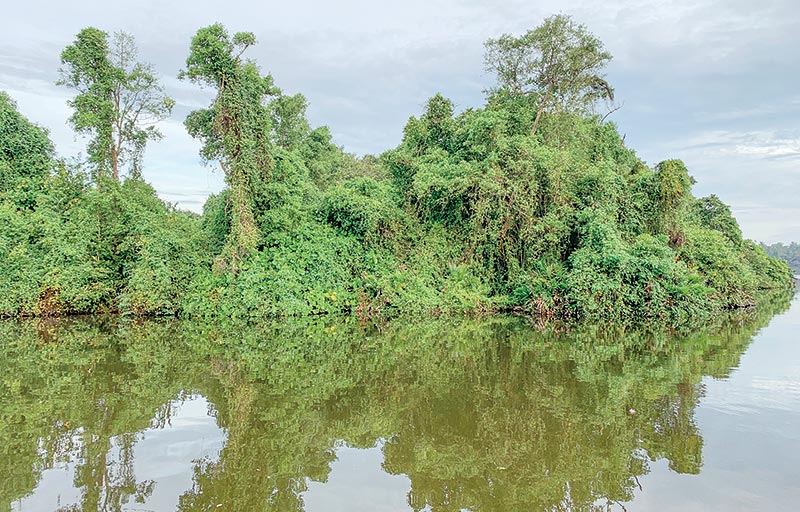New Islands of Hope: Geoffrey Bawa Trust and WNPS PLANT unite to restore Lanka’s vanishing ecosystems
Spanning over 24 acres of mangrove and semi-forested land, the islands are dedicated to long-term conservation and habitat restoration with specific targets outlined in the MoU. At a time when forest preservation in Sri Lanka is heavily reliant on state-managed reserves, this partnership is a further testament to a visionary model spearheaded by the Wildlife and Nature Protection Society (WNPS) for private land conservation, where civil society and heritage stewards take the lead in protecting biodiversity.
The Geoffrey Bawa Trust: Where Architecture Meets Ecology
Founded to protect and promote the legacy of Sri Lanka’s most celebrated architect, the Geoffrey Bawa Trust manages a portfolio of architectural and landscape treasures, including the iconic Lunuganga Estate. The Lunuganga Trust bears the organization’s ecological mandate, and stewards associated lands such as Honduwa and Appaladuwa, originally set aside by Geoffrey Bawa for environmental preservation. Building on Bawa’s emphasis on ecology and environmental studies as complements to art and architecture, the Trust today advances that vision through conservation projects (www.geoffreybawa.com). The presence of the Critically Endangered Hog Deer (Axis porcinus) on Honduwa island makes the conservation initiative especially significant.
As Channa Daswatte, the Chairperson of the Geoffrey Bawa and Lunuganga Trusts noted, “This is far more than a simple conservation project. It is a deliberate continuation of Bawa’s enduring legacy that invites us to see land not just as a passive backdrop for architectural design, but as a dynamic, living entity that evolves over time. It calls upon us to recognize the intrinsic value of the land itself, honoring it as something sacred and deserving of careful stewardship and protection for generations to come. In WNPS PLANT, we have a passionate partner who shares a vision for Sri Lanka in which people and species can better coexist”.
WNPS PLANT: A Conservation Vision Rooted in Connectivity
Established under the wings of the WNPS, PLANT is a visionary conservation initiative dedicated to restoring habitat connectivity through privately owned lands. Its flagship initiative, Emerald Trails, seeks to build a network of forest corridors and private conservation spaces, especially in the country’s endemic-rich southwestern quadrant, linking fragmented ecosystems and providing safe passage for wildlife. With work already underway in over 30 locations, PLANT combines science, restoration, and long-term land stewardship (www.plantsl.org).
“We are delighted and honoured to partner with the Bawa Trust and its properties,” says Sriyan de Silva Wijeyeratne, Chairman of PLANT. “This partnership is especially meaningful because it allows us to connect conservation with cultural heritage. We are creating ecosystems, and, in this case, we are not just working with land; we are working with legacy. It is a powerful reminder that stewardship can replace ownership and that conservation can be a cultural act as much as an ecological one. Many large cultural locations have the opportunity to allocate some spaces for conservation as well, which is when culture truly embraces humanity holistically. We hope this engagement will inspire other partners to follow this thought process”, he further added.
A Blueprint for Restoration
The MoU outlines a multi-faceted plan centered on habitat protection, research, education, and community engagement. At the heart of the agreement is a commitment to protect the entire island forest area from deforestation, agriculture, or major development. To establish a scientific baseline and monitor ecological progress, the partners will initiate a biodiversity survey in the project’s first year, collaborating with experts across academia and conservation practice. Restoration efforts will include the planting of a few thousand native trees and understory plants, carefully selected for ecological compatibility and planted under expert supervision. Extra focus will also go into the removal of invasive species and the strengthening of the Hog Deer population, with active work aimed at improving their habitat quality, food sources and population health.
“The project also includes a strong educational component. The islands will serve as living classrooms for researchers and conservation professionals, with opportunities for ecological studies and learning exchanges. We also hope to engage local community as conservation practitioners and ecological stewards through dialogue and collaboration. To ensure long-term sustainability of the project, the two organizations will jointly develop a fundraising strategy targeting local and international donors and funds will be used to support habitat restoration, ecosystem monitoring, education, and outreach” said Soham Kacker, Curator of Living Collections at Lunuganga.
Where Nature and Legacy Converge
Bawa’s design ethos celebrated the integration of the built form with the surrounding environment. This partnership reimagines the ecological dimensions of that philosophy through native trees, regenerating undergrowth, and the quiet return of wildlife. As Sri Lanka grapples with climate instability and increasing habitat fragmentation, the significance of this partnership extends beyond the islands themselves. The PLANT initiative serves as a compelling model for decentralized, citizen-led conservation. It demonstrates how visionary landowners, heritage organizations, and conservationists can collectively protect what is too often overlooked- small, fragmented, but ecologically vital landscapes.
Once known primarily for their proximity to cultural heritage sites, Honduwa and Appaladuwa are now being shaped into thriving habitats through ecological restoration. Camera traps will monitor returning wildlife; native species will be reintroduced and nurtured. Slowly, the rhythms of natural forest life will return. In a time when environmental headlines are dominated by loss, this project offers a quiet but powerful counter-narrative: that restoration is possible, that heritage can drive conservation, and that even forgotten forests can be islands of hope.
This article first appeared in The Island on the 10th of August 2025.


